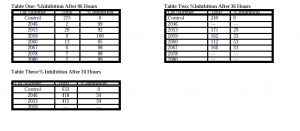Rachel L. Robison and Dr. James B. Jensen, Microbiology
Investigations have determined that people living in areas where malaria is widespread have developed an acquired immune response that resists the malaria parasite. Normally, the malaria parasite enters the cell and takes over certain cellular functions. This cellular invasion provides nutrients to the parasite which perpetuates its life cycle. In cases where an immune response has been developed, the immune system produces antibodies which prevent the malaria parasite from invading the erythrocyte. This type of immune response is effective through two possible mechanisms. The first mechanism prevents parasite attachment to the erythrocyte plasma membrane. The second mechanism restricts the parasite from entering the cell.
This paper reports on research designed to demonstrate that in a culture system, antibodies from immune serum increases parasite inhibition. This research also demonstrates that antibody concentration in culture increases over time. With increasing antibody concentration, parasite growth is limited because the antibody interrupts part of the asexual reproductive cycle of the parasite.
In order to test immune serum against the parasites, a culture system was developed. The malaria cultures used in the following experiments, were maintained according to the protocol outlined in an article written by Trager and Jensen in Science Magazine in 1992. As part of the protocol, the cultures have fresh medium containing; RPMI 1640, Hepes Buffer, NaHCO3, penicillin and calf serum added every 24 hours. The malaria cultures also require fresh erythrocytes a minimum of every four days. Immune serum is added to this standard medium as the source of the anti-malarial antibodies. The immune serum is added to the standard medium to make it 10% immune serum concentrated.
In all of the experiments conducted, the immune serum was limited to 10% concentration. The variable in the experiment was the time frame of each experiment. In the first experiment, the cultures ran for a 96 hour period with fresh medium added three times. Then slides were made from each dish and cells counted in order to determine an approximate percentage of parasite inhibition. Table I lists the data from this experiment. Results revealed that all of the cultures containing immune serum showed close to 100% inhibition.
In experiment two the cultures ran for 36 hours and the medium was changed twice. Again, slides from each sample were taken and cells counted to determine a percent inhibition. Table two lists the data collected from this experiment. After counting the cells, the results revealed that there was significantly less parasite inhibition than found in experiment one. This is significant because experiment I was treated with the same immune serums as used in experiments two and three. Experiment one showed that culturing the parasites in immune serum for a longer amount of time caused almost complete inhibition while parasites in immune serum for 36 hours had significantly less parasite inhibition.
The third experiment ran for 24 hours with no medium changes. In this experiment there was significantly less inhibition of the parasites than had occurred in either the 36 or the 96 hour experiments as shown in Table three.
This decrease in inhibition can be explained by examining the conditions of each experiment. First, when the culture was allowed to run for 96 hours the medium was changed every 24 hours therefore replenishing the antibody concentration. By adding fresh serum, the concentration of antibody per unit of infected erythrocytes increased. Since antibodies are responsible for inhibiting the parasite from entering the erythrocyte the experiment with the highest concentration of antibody is also the most inhibitory. Additionally the 96 hour experiment had the highest level of inhibition because the asexual life cycle of the parasite completes the whole cycle in 42-46 hours. If the cultures are tested over 96 hours there is greater chance for the antibody to encounter the parasite while it is in the re-invasion stage of its life cycle called the merozoite stage. If the antibody clumps around the merozoite, it is no longer free to invade a new erythrocyte.
In the 36 and 24 hour experiments the antibody concentration is not as high as it was in the 96 hour experiment due to the fewer times that the medium was changed. As a result of having a decreased concentration and a shorter time period, the number of parasites invading fresh erythrocytes was reduced. These experiments show that the conditions of the cultures change over time, and because of this, comparisons of experiments can only be made in reference to experiments done with in the same time frame.

